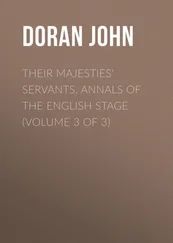John Dent - The Canadian Portrait Gallery - Volume 3 (of 4)
Здесь есть возможность читать онлайн «John Dent - The Canadian Portrait Gallery - Volume 3 (of 4)» — ознакомительный отрывок электронной книги совершенно бесплатно, а после прочтения отрывка купить полную версию. В некоторых случаях можно слушать аудио, скачать через торрент в формате fb2 и присутствует краткое содержание. Жанр: foreign_antique, foreign_prose, на английском языке. Описание произведения, (предисловие) а так же отзывы посетителей доступны на портале библиотеки ЛибКат.
- Название:The Canadian Portrait Gallery - Volume 3 (of 4)
- Автор:
- Жанр:
- Год:неизвестен
- ISBN:нет данных
- Рейтинг книги:5 / 5. Голосов: 1
-
Избранное:Добавить в избранное
- Отзывы:
-
Ваша оценка:
- 100
- 1
- 2
- 3
- 4
- 5
The Canadian Portrait Gallery - Volume 3 (of 4): краткое содержание, описание и аннотация
Предлагаем к чтению аннотацию, описание, краткое содержание или предисловие (зависит от того, что написал сам автор книги «The Canadian Portrait Gallery - Volume 3 (of 4)»). Если вы не нашли необходимую информацию о книге — напишите в комментариях, мы постараемся отыскать её.
The Canadian Portrait Gallery - Volume 3 (of 4) — читать онлайн ознакомительный отрывок
Ниже представлен текст книги, разбитый по страницам. Система сохранения места последней прочитанной страницы, позволяет с удобством читать онлайн бесплатно книгу «The Canadian Portrait Gallery - Volume 3 (of 4)», без необходимости каждый раз заново искать на чём Вы остановились. Поставьте закладку, и сможете в любой момент перейти на страницу, на которой закончили чтение.
Интервал:
Закладка:
The family from which he sprang has long been celebrated both in English and continental history. Readers of Shakespeare's historical plays are, it is to be hoped, sufficiently familiar with that "scourge of France" who was defied by Joan of Arc, and who, with his son, John Talbot, fell bravely fighting his country's battles on the field of Castillon, near Bordeaux. It would be difficult for a man to sustain the burden of a long line of such ancestors as these. It is therefore reassuring to learn that the Talbot line has been diversified by representatives of another sort. Readers of Macaulay's History are familiar with the name of Richard Talbot, that noted sharper, bully, pimp and pander, who haunted Whitehall during the years immediately succeeding the Restoration; whose genius for mendacity procured for him the nickname of "Lying Dick Talbot;" who became the husband of Frances Jennings; who slandered Anne Hyde for the money of the Duke of York; who, in a word, was one of the greatest scoundrels that figured in those iniquitous times; and who was subsequently raised by James II. to the Earldom of Tyrconnel. "Lying Dick" was a member of the Irish branch of the Talbot family, which settled in Ireland during the reign of Henry II., and became possessed of the ancient baronial castle of Malahide, in the county of Dublin. The Talbots of Malahide trace their descent from the same stock as the Talbots who have been Earls of Shrewsbury, in the peerage of Great Britain, since the middle of the fifteenth century. The father of the subject of this sketch was Richard Talbot, of Malahide. His mother was Margaret, Baroness Talbot; and he himself was born at Malahide on the 17th of July, 1771.
All that can be ascertained about his childhood is that he spent some years at the Public Free School at Manchester, and that he received a commission in the army in the year 1782, when he was only eleven years of age. Whether or not he left school immediately after obtaining this commission does not appear, but his education must have been very imperfect, as he was not of a studious disposition, and in 1786, when he was only sixteen, we find him installed as an aide-de-camp to his relative the Marquis of Buckingham, who was then Lord Lieutenant of Ireland. His brother aide was the Arthur Wellesley already referred to. The two boys were necessarily thrown much together, and each of them formed a warm attachment for the other. Their future paths in life lay far apart, but they never ceased to correspond, and to recall the happy time they had spent together,
“Yearning for the large excitement that
the coming years would yield.”
Young Talbot continued in the position of aide-de-camp for several years. In 1790 he joined the 24th Regiment, which was then stationed at Quebec, in the capacity of Lieutenant. We have no record of his life during the next few months. Upon the arrival of Lieutenant-Governor Simcoe at Quebec, at the end of May, 1792, Lieutenant Talbot, who had nearly completed his twenty-first year, became attached to the Governor's suite in the capacity of private secretary. He continued to form part of the establishment of Upper Canada's first Lieutenant-Governor until just before the latter's removal from this country. "During that period," says General Simcoe, writing in 1803, "he not only conducted many details and important duties incidental to the original establishment of a colony, in matters of internal regulation, to my entire satisfaction, but was employed in the most confidential measures necessary to preserve the country in peace, without violating, on the one hand, the relations of amity with the United States; and on the other, alienating the affection of the Indian nations, at that period in open war with them. In this very critical situation, I principally made use of Mr. Talbot for the most confidential intercourse with the several Indian Tribes; and occasionally with his Majesty's Minister at Philadelphia; and these duties, without any salary or emolument, he executed to my perfect satisfaction."
It seems to have been during his tenure of office as secretary to Governor Simcoe that the idea of embracing a pioneer's life in Canada first took possession of young Talbot's mind. It has been alleged that his imagination was fired by reading a translation of part of Charlevoix's "Historie Générale de la Nouvelle France," a work which describes the writer's own experiences in the wilds of Canada in a pleasant and easy fashion. This idea is probably attributable to an assertion made by Colonel Talbot himself to Mrs. Jameson, when that lady visited him during her brief sojourn in Upper Canada. "Charlevoix," said he, "was, I believe, the true cause of my coming to this place. You know he calls this the Paradise of the Hurons. Now I was resolved to get to Paradise by hook or by crook, and so I came here." It is much more probable, however, that he was influenced by his own experiences in the Canadian forest, which for him would possess all the charm of novelty, in addition to its natural beauties. He accompanied the Lieutenant-Governor hither and thither, and traversed in his company the greater part of what then constituted Upper Canada. He formed a somewhat intimate acquaintance with the Honourable William Osgoode, the first Chief Justice of this Province, who was for some time an inmate of Governor Simcoe's abode at Niagara — or Newark, as it was then generally called. The Chief Justice felt the isolation of his position very keenly, and was doubtless glad to relax his mind by communion with the young Irish lieutenant, who possessed no inconsiderable share of the humour characteristic of his nationality, and could make himself a boon companion. At this time there would seem to have been nothing of the misanthrope about Lieutenant Talbot. He seemed to take fully as much enjoyment out of life as his circumstances admitted of. His constitution was robust, and his disposition cheerful. He was prim, and indeed fastidious about his personal appearance, and was keenly alive to everything that was going on about him. He was popular among all the members of the household, and was the especial friend of Major Littlehales, the adjutant and general secretary, whose name is familiar to most persons who take an interest in the history of the early settlement of this Province.
On the 4th of February, 1793, an expedition which was destined to have an important bearing upon the future life of Lieutenant Talbot, as well as upon the future history of the Province, set out from Navy Hall 1 1 Navy Hall was the Lieutenant-Governor's residence at Newark. See the sketch of the life of Governor Simcoe, in the first volume of this work.
to explore the pathless wilds of Upper Canada. It consisted of Lieutenant-Governor Simcoe himself and several of his officers, among whom were Major Littlehales and the subject of the present sketch. The Major kept a diary during the journey, which was given to the world more than forty years afterwards in the Canadian Literary Magazine , a periodical of which several numbers were published in Toronto in 1834. The expedition occupied five weeks, and extended as far as Detroit. The route lay through Mohawk village, on the Grand River, where the party were entertained by Joseph Brant; thence westward to where Woodstock now stands; and so on by a somewhat devious course to Detroit, the greater part of the journey being necessarily made on foot. On the return journey the party camped on the present site of London, which Governor Simcoe then pronounced to be an admirable position for the future capital of the Province. One important result of this long and toilsome journey was the construction of Dundas Street, or, as it is frequently called, "the Governor's Road." The whole party were delighted with the wild and primitive aspect of the country through which they passed, but not one of them manifested such enthusiasm as young Lieutenant Talbot, who expressed a strong desire to explore the land farther to the south, bordering on Lake Erie. His desire was gratified in the course of the following autumn, when Governor Simcoe indulged himself and several members of his suite with another western excursion. During this journey the party encamped on the present site of Port Talbot, which the young Lieutenant declared to be the loveliest situation for a dwelling he had ever seen. "Here," said he, "will I roost, and will soon make the forest tremble under the wings of the flock I will invite by my warblings around me." Whether he was serious in this declaration at the time may be doubted; but, as will presently be seen, he ultimately kept his word.
Интервал:
Закладка:
Похожие книги на «The Canadian Portrait Gallery - Volume 3 (of 4)»
Представляем Вашему вниманию похожие книги на «The Canadian Portrait Gallery - Volume 3 (of 4)» списком для выбора. Мы отобрали схожую по названию и смыслу литературу в надежде предоставить читателям больше вариантов отыскать новые, интересные, ещё непрочитанные произведения.
Обсуждение, отзывы о книге «The Canadian Portrait Gallery - Volume 3 (of 4)» и просто собственные мнения читателей. Оставьте ваши комментарии, напишите, что Вы думаете о произведении, его смысле или главных героях. Укажите что конкретно понравилось, а что нет, и почему Вы так считаете.












